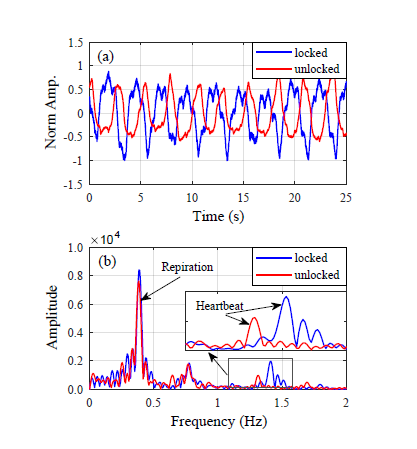Ying Zhang and Zongyang Xia from the School of Electrical and Computer Engineering at Georgia Tech have developed and experimentally demonstrated the use of a non-contact vital sign detection system using phase locked loop (PLL) to automatically suppress the residual phase noise. A PLL is a negative feedback scheme that synchronizes the output signal with a reference. The designed dual-carrier system uses PLL to lock the phase of one carrier’s beat signal to a low-noise reference signal to suppress the residual phase noise, providing a clean transmission path for the other carrier. When compared to a similar but unlocked setup, results show that the developed system improves signal to noise ratio by 50% at 50 cm (see graph above). The developed system is also used to successfully measure heartbeat at 250 cm (more than double the distance of the unlocked system) and at four physical orientations.
- Automatically adjusts the feedback signals to suppress the noise when the measurement environment changes
- Improves SNR by 50% at 50 cm when compared to an unlocked system
- Detects heartbeat at 250 cm, more than twice the distance of the unlocked system
- Detects heartbeat in four physical orientations
- As the noise level is reduced by the PLL, it has higher SNR ratio and longer detection distance
Non-contact vital sign detection systems have applications in biomedical monitoring, health-care, fitness monitoring, physical monitoring of astronauts/drivers/pilots, and search and rescue operations.
There has been growing interest in developing non-contact vital sign detection systems. Various wireless solutions have been developed. Comparing with stepped-frequency continuous wave, frequency modulated continuous wave, and impulse-based ultra-wideband radar, continuous-wave (CW) Doppler radar can easily reach a resolution of submillimeter and is suitable for vital sign detection. The Doppler radar transmits a microwave signal which is phase modulated by the chest surface displacement due to respiration and heartbeat, and the vital sign information is exhibited in the phase variation of microwave signal. In the detection process, residual phase noise can contaminate the received wave, reducing the quality of the vital sign information. Reducing the phase noise can help extract more accurate vital sign information, and extend the detection range.

